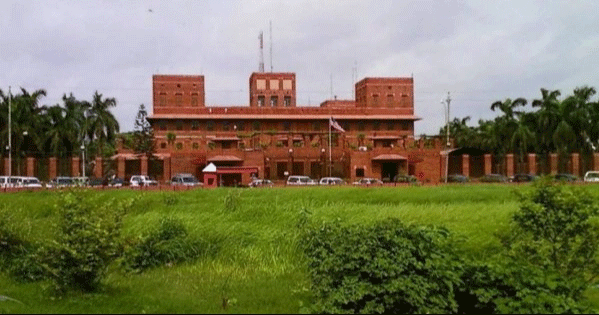Govt paying debt by borrowing fund
Mahfuz Emran: Revenue collection is not increasing despite the increase in expenditure. To meet the deficit, the government has to take loans from domestic and foreign sources. The debt status of the government from domestic and foreign sources is also increasing. At the end of the financial year 2021-22, the total debt status of the government was Tk 13 lakh 43 thousand 724 crores. At the end of the last financial year (2022-23), it has increased to Tk 16 lakh 17 thousand 313 crores. According to the calculation of the Debt Bulletin published by the Finance Department last month, the debt status of the government has increased by Tk 2 lakh 73 thousand 589 crores in the last financial year, which is equivalent to about 83 percent of the total revenue collected by the government at that time. In the fiscal year 2022-23, the revenue of the government was Tk 3 lakh 31 thousand 454 crores.
This disparity in revenue and debt is increasing the pressure on the government’s coffers. The amount of money paid for interest on the loan is also increasing. In the last financial year, the government had to pay interest on the loan more than the allocation. In the last financial year, Tk 90 thousand 13 crore were allocated for the payment of loan interest in the budget. Although Tk 92 thousand 538 crores had to be paid.
The government had to increase the collection of money from internal as well as external sources to repay the loan installments and meet the additional interest expenses. Economists and related parties say that the government now has to take more loans to repay the debt. In addition to incidental expenses including interest, the level of macroeconomic risk is also increasing now.
The contribution of foreign debt is the highest in this additional debt. In the last financial year, the state of loans taken from local sources in the country increased by Tk 96 thousand 406 crores. And the foreign debt has increased by Tk 1 lakh 77 thousand 183 crores. Economists and analysts are becoming alarmed by the increasing reliance on foreign debt. They fear that this risk will become more evident due to devaluation of money and dollar crisis.
Analysts say that if the revenue income is not increased, the loans taken from domestic and foreign sources may become a big danger for Bangladesh. Although the debt-GDP ratio is still at a bearable level, the debt-revenue ratio here is much higher than that of the homogenous economies.
Economist and Executive Director of Policy Research Institute (PRI) Ahsan H. Mansoor, a businessman told, “One of the reasons for the increase in debt in the last financial year is the devaluation of rupees against the dollar.
If we are not able to maintain macroeconomic stability, it will become a huge burden for us. If our debt continues to increase every year, we will lose revenue due to debt burden. The increase in debt is almost equal to our revenue. This indicates the extent of our risk. Our revenue is incredibly low. Another important thing is that our debt-to-income ratio has gone from 350 to 400 percent.
That means our debt is equal to three and a half to four years of revenue, which is a lot. India’s debt-to-GDP ratio is 90 percent, but their debt-to-revenue ratio is lower than ours. In the US, the debt-to-GDP ratio is 110 percent and the debt-to-revenue ratio is 300 percent. We have to repay the debt with revenue money, not with GDP.
According to the information of the Ministry of Finance, at the end of the financial year 2021-22, the status of loans taken from local sources was Tk 8 lakh 47 thousand 930 crores, which stood at Tk 9 lakh 44 thousand 335 crores at the end of the 2022-23 financial year. During the same period, the amount of foreign debt increased from Tk 4 lakh 95 thousand 794 crore to Tk 6 lakh 72 thousand 977 crore. In the last financial year, the government had to pay interest of Tk 83 thousand 86 crore against local debt and Tk 9 thousand 452 crore against foreign debt.
The government’s borrowing from both the banking and non-banking sectors has increased in the last financial year among local sources of credit. Out of this, the banking sector increased by Tk 88 thousand 136 crores. In this sector, the debt status raised through Treasury Bills and Treasury Bonds and SPTB increased. Unchanged was debt raised through sukuk. On the other hand, among the non-banking sector, the amount of loans taken through savings certificates has decreased slightly, but the loans taken from other (GPF) sources have increased.
Sub-Saharan countries have a history of being in danger of borrowing more than they can handle. Even the Asian economic crisis at the end of the last century was at the root of the propensity to borrow freely. Analysts are warning that the large amount of debt can also be a trap for Bangladesh. That is why they are advising the government to spend in proportion to the income.
Former secretary of the government and former chairman of the National Board of Revenue (NBR) Mohammad Abdul Majeed told, “The countries of the sub-Saharan region were in such a situation in the eighties and nineties. The wealth of these countries was very less. They borrowed so much from abroad that at one point they had to take out loans and repay the loan installments. At that time, they are forced to pay off the easy terms loan with hard terms loans. Needless to say, Bangladesh is also going to fall into this kind of debt trap. Until 2014, Bangladesh received loans on easy terms. But since then, the government has built up large reserves of foreign currency and used it as leverage to take out foreign loans on onerous terms. Another aspect is that the government announces the target of moving up to middle income countries. In this situation, lenders lose interest in lending on easy terms.
He also said, ‘The Asian economic crisis in 1997 was also influenced by excessive debt. At that time, countries like Japan and Thailand invested huge sums of money in the housing sector with loan money. But later on, the banks are in danger as the sale of apartments is not at the desired rate. In this situation, the banks were saved by money from the government treasury. However, this assistance was possible due to the good financial health of the countries. Since we are not getting revenue at the desired rate here, how reasonable is it to implement big projects with large amount of debt; That is the question. It will be appropriate to spend according to the amount of income we are getting.
A review of the government’s debt status shows that the debt has increased the most in the last quarter (April-June) of the last financial year 2022-23. In the last quarter of the financial year 2021-22, the debt increased by Tk 1 lakh 4 thousand 609 crore. And in the same period of the fiscal year 2022-23, it increased to Tk 1 lakh 68 thousand 980 crores. During this period, the loan taken from local sources increased by Tk 29 thousand 200 crore and the foreign loan increased by Tk 1 lakh 39 thousand 780 crore.
Government policymakers, however, say there are risks to the loan, but they have been taken into account. For this reason, the government is now emphasizing on increasing the amount of export income and remittance collection. Moreover, the return from infrastructure development is also going to increase. In this, debt repayment will not pose a risk to the country in the future.
Planning Minister MA Mannan told, “There is definitely a risk, there is no risk-free country in the world.” But if the risks are calculated, there is no reason to fear. We hope, not only the loan ahead; Income will also increase. The economy is expanding, growing. The amount of income will also increase. Development would not have been possible without taking risks. Everything would have come to a standstill. We have invested heavily in the infrastructure sector and expect huge returns from it. Something is coming. But one thing we are borrowing in dollars, but earning in rupees. Now we need to increase our income in dollars. It means that the income should be increased by diversifying the exports. Besides, the amount of remittance should also be increased.
In the report of the Ministry of Finance, only the information of the loans taken by the government has been highlighted. It does not include loans taken by government institutions. If added to that, the amount of debt of the government increases further. According to the foreign debt statistics of Bangladesh Bank published by adding the data of loans received by government institutions, the amount of foreign debt of the government at the end of June 2023 was $8.28 million (equal to 108 taka per dollar). The total foreign debt of Bangladesh at that time was $ 9893 crore 54 lakh 70 thousand dollars or Tk 10 lakh 68 thousand 503 crore. At the end of September this year, the amount of foreign debt of the country exceeded $10 thousand billion ($100 billion).
Incidentally, at the end of June 2022, the rate was Tk 93.45 per dollar. At the end of June this year, it stood at Tk 108. Last Thursday, the rate per dollar was Tk 111.
President Joe Biden tests positive for COVID-19 while campaigning in Las Vegas, has ‘mild symptoms’
International Desk: President Joe Biden tested positive for COVID-19 while traveling Wedne…








